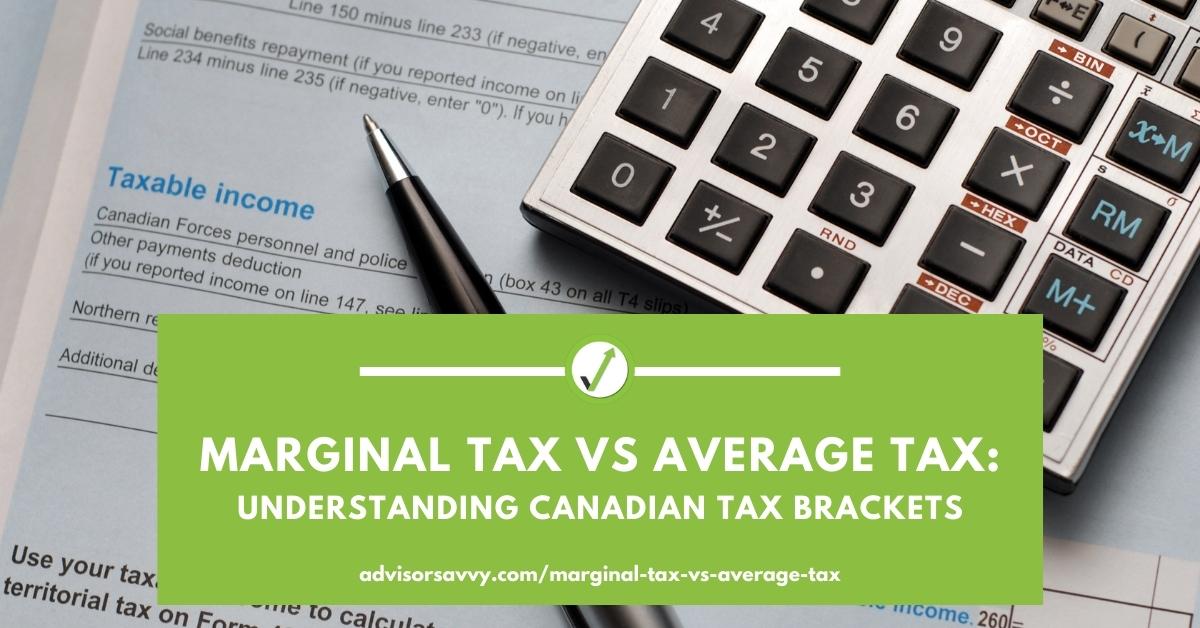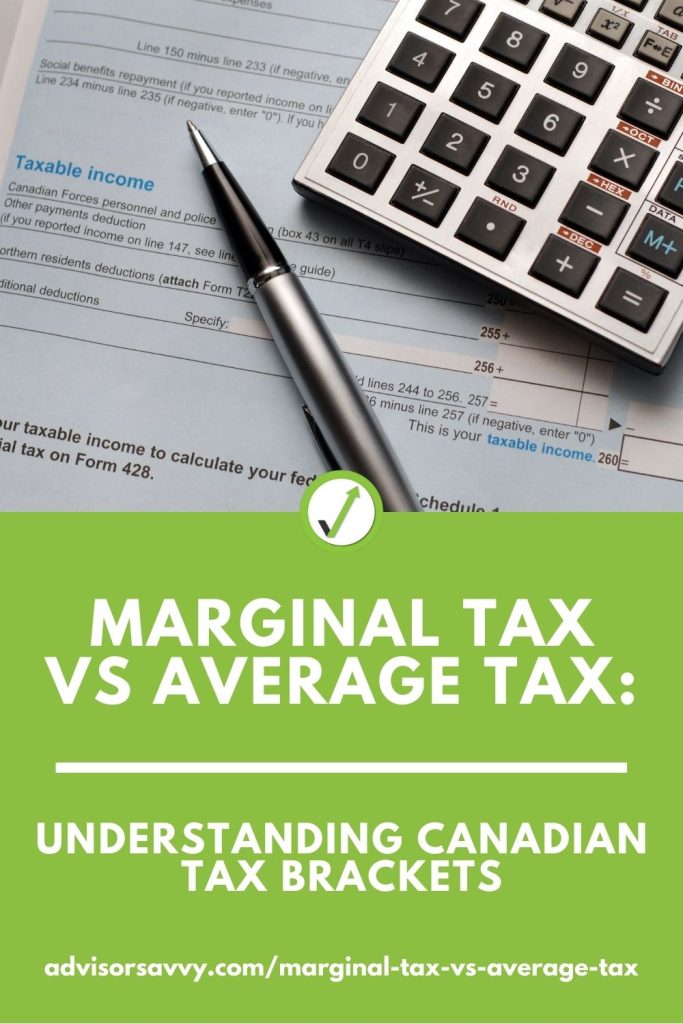
Tax rate, tax bracket, marginal tax, average tax — there sure is a lot of tax-related terminology floating around, isn’t there? In our previous blog post, we discussed the ins and outs of tax credits and deductions in Canada, and how you can get a bigger tax refund. This time, we’re zooming out a little bit, tackling the differences in marginal tax vs average tax, and just what tax bracket you might fall into in the first place.
This will ultimately help you better understand and plan your finances, and how/when you can claim tax credits or deductions and overall better plan for tax season.

Table of contents
What is the average tax rate?
The average tax rate measures your tax burden — i.e. the share of income you pay in taxes. It’s calculated by taking the total tax you paid and dividing it by your total income. Ultimately, it’s an accurate reflection of overall tax liability.
Related Reading: Tax Credit vs Tax Deduction in Canada
What is the marginal tax rate?
Simply put, your marginal tax rate is the highest tax bracket (and its corresponding rate) that applies to your last dollar of income. As your income goes up, so does your tax rate. In other words, your marginal tax rate is the additional rate of tax you pay for every additional dollar earned.
When it comes to financial planning, having a general idea of your marginal tax rate is helpful because it gives you an idea of how much money will be yours to spend, save, and invest. For example, knowing this rate can help you get the most out of RRSP and retirement planning.
(And making financial decisions on your total income instead of your net income is setting yourself up for disappointment!)
Related Reading: Tax Efficient Retirement Withdrawal Strategies in Canada
What does marginal tax rate mean in Canada?
Canada’s tax system is progressive — the more you earn, the more tax you pay — so the provincial and federal governments have set tax brackets based on taxable income. These are adjusted each tax year because of inflation and other factors. Below are the tax brackets for the 2023 tax year:
| 2023 Federal Income Tax Bracket | 2023 Federal Income Tax Rate |
| $55,687 or less | 15% |
| $55,687 to $111,733 | 20.5% |
| $111,733 to $173,205 | 26% |
| $173,205 to $246,752 | 29% |
| $246,752 and above | 33% |
Remember that these are just the federal tax brackets and rates. Each province and territory in Canada has their own set of tax brackets too, as we’ll discuss below.
How do marginal tax rates work?
Let’s say your taxable income for 2023 will be $60,000. You’ll pay:
- 15% on the amount up to $55,687, or $8,353.05
- 20.5% on the amount between $55,687 and $111,733, which is $884.17 (i.e. 20.5% of $60,000 less $55,687)
Your total federal tax payable is $9,237.22 in this scenario. This might seem crazy high, but remember tax credits are taken off this amount which will reduce your liability. In addition, if you’re employed (not self-employed), a little bit of federal tax is taken off each of your pay cheques. This means you won’t have to pay as much in April.
Marginal tax rates come into play when you earn more money in Canada. As we saw above, the tax rate is the same when your income is $55,687 or less. But as soon as you earn $1 over $55,687, your tax rate increases from 15% to 20.5% on the additional income. By considering the marginal tax rate, you can have better control over your tax liability.
A great example of this is with RRSPs. When Canadians retire, they can begin withdrawing from their RRSP to support their lifestyle in retirement. RRSP withdrawals are considered income and are subject to taxation. So, if retirees only withdraw $55,687 or less during the year, they can ensure they only pay 15% tax. If the individual were to withdraw more, they’d put themselves in a higher tax bracket which means their tax liability would go up. By controlling RRSP withdrawals, retirees can minimize their tax burden.
ICYMI: See our guide to tax credits and deductions!
What is the main difference between the average and marginal tax rates?
The primary difference between marginal and average tax rates is that your average tax rate measures your actual tax burden. On the other hand, marginal tax rates are more so a concept that can be applied as a method of forecasting your tax liability.
To compare marginal tax vs average tax, let’s use the above example of $60,000 in taxable income. The average federal tax rate works out to 15.4% ($9,237.22 divided by $60,000).
Your marginal federal tax rate, however, is 20.5% since that’s the tax bracket where your last dollar of income fell.
Why is my marginal tax rate higher than my average tax rate?
When looking at marginal tax vs average tax, there are three main reasons why the former is higher.
First of all, not all income is taxed. Thanks to deductions — like RRSP tax deductions, work from home expenses, and self-employment expenses — it’s fairly easy to reduce your overall taxable income after you’ve calculated your total income (line 15000 of your tax return).
Secondly, as explained above, your marginal tax rate only applies to your last dollar of income. Under Canada’s tax brackets, only a portion of your income is taxed at a higher rate.
Finally, we have two words: tax credits! While tax deductions work to decrease your taxable income, tax credits reduce your tax liability.
ICYMI: The Canadian government’s a complete list of deductions, credits, and expenses
Since your marginal tax rate is based on a specific bracket, your marginal tax rate doesn’t actually end up reflecting the total tax payable on your income. Factoring in tax credits and deductions lowers what you owe, and therefore your average tax rate goes down.
Related Reading: Is CPP Taxable Income?
Provincial and territorial tax brackets for the 2023 tax year
Specifically, Quebec collects and manages its own income taxes. For all other provinces/territories, the Canadian government collects these specific taxes and returns them to the jurisdictions through various programs. On top of your federal taxes, you must also pay tax in your province or territory of residence.
Related Reading: Combined Federal and Provincial Tax Rates
Newfoundland
| 2023 Tax Rates | 2023 Taxable Income |
| 8.7% | First $35,148 |
| 14.5% | $35,148 to $70,295 |
| 15.8% | $70,296 to $125,500 |
| 17.3% | $125,501 to $175,700 |
| 18.3% | Over $175,700 |
Prince Edward Island
| 2023 Tax Rates | 2023 Taxable Income |
| 9.8% | First $31,984 |
| 13.8% | $31,984 to $63,969 |
| 16.7% | Over $63,969 |
Nova Scotia
| 2023 Tax Rates | 2023 Taxable Income |
| 8.79% | First $29,590 |
| 14.95% | $29,590 to $59,180 |
| 16.67% | $59,180 to $93,000 |
| 17.5% | $93,000 to $150,000 |
| 21% | Over $150,000 |
New Brunswick
| 2023 Tax Rates | 2023 Taxable Income |
| 9.4% | First $47,715 |
| 14% | $47,715 to $95,431 |
| 16% | $95,431 to $176,756 |
| 19.5% | Over $176,756 |
Quebec (via Revenu Québec)
| 2023 Tax Rates | 2023 Taxable Income |
| 14% | First $51,780 |
| 19% | $51,780 to $103,545 |
| 24% | $103,545 to $126,000 |
| 25.75% | Over $126,000 |
Ontario
| 2023 Tax Rates | 2023 Taxable Income |
| 15% | First $55,687 |
| 20.5% | $55,687 to $111,733 |
| 26% | $111,733 to $173,205 |
| 29% | $173,205 to $246,752 |
| 33% | Over $246,752 |
Manitoba
| 2023 Tax Rates | 2023 Taxable Income |
| 10.8% | First $36,842 |
| 12.75% | $36,842 to $79,625 |
| 17.4% | Over $79,625 |
Saskatchewan
| 2023 Tax Rates | 2023 Taxable Income |
| 10.5% | First $49,720 |
| 12.5% | $49,720 to $142,058 |
| 14.5% | Over $142,058 |
Alberta
| 2023 Tax Rates | 2023 Taxable Income |
| 10% | First $142,292 |
| 12% | $142,292 to $170,751 |
| 13% | $170,751 to $227,668 |
| 14% | $227,668 to $341,502 |
| 15% | Over $341,502 |
British Columbia
| 2023 Tax Rates | 2023 Taxable Income |
| 5.06% | First $45,654 |
| 7.7% | $45,654 to $91,310 |
| 10.5% | $91,310 to $104,835 |
| 12.29% | $104,835 to $127,299 |
| 14.7% | $127,299 to $172,602 |
| 16.8% | $172,602 to $240,716 |
| 20.5% | Over $240,716 |
Yukon
| 2023 Tax Rates | 2023 Taxable Income |
| 6.4% | First $53,359 |
| 9% | $53,359 to $106,717 |
| 10.9% | $106,717 to $165,430 |
| 12.93% | $165,430 to $235,675 |
| 12.8% | $235,675 to $500,000 |
| 15% | Over $500,000 |
Northwest Territories
| 2023 Tax Rates | 2023 Taxable Income |
| 5.9% | First $48,326 |
| 8.6% | $48,326 to $96,655 |
| 12.2% | $96,655 to $157,139 |
| 14.05% | Over $157,139 |
Nunavut
| 2023 Tax Rates | 2023 Taxable Income |
| 4% | First $50,877 |
| 7% | $50,877 to $101,754 |
| 9% | $101,754 to $165,429 |
| 11.5% | Over $165,429 |
Related Reading: Is OAS Taxable?

